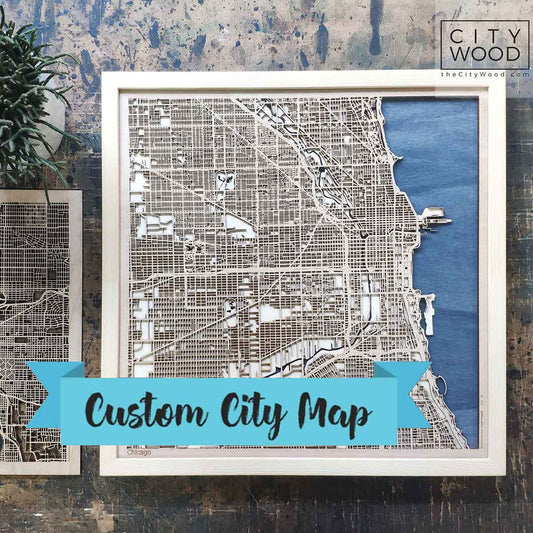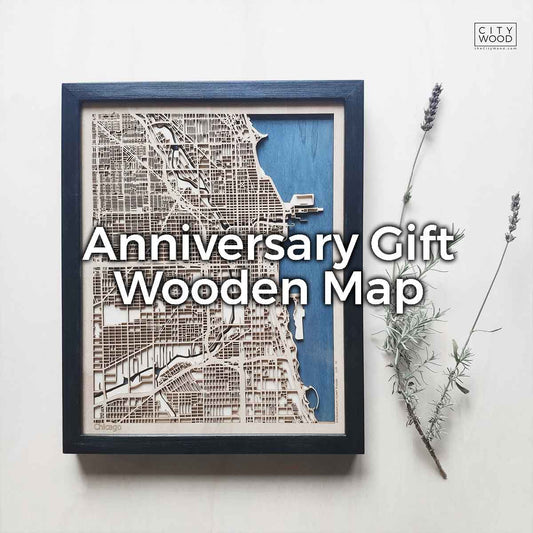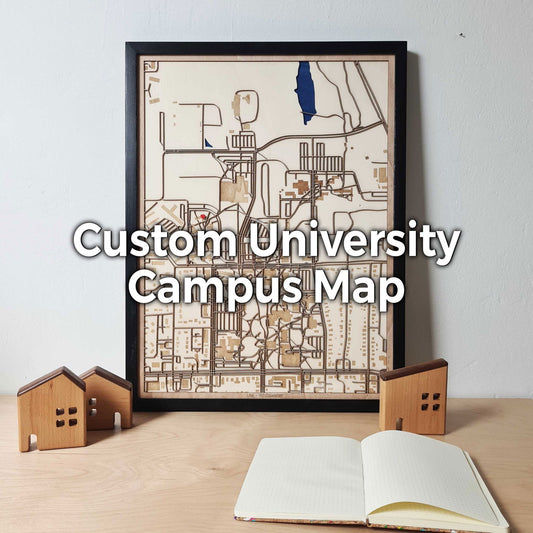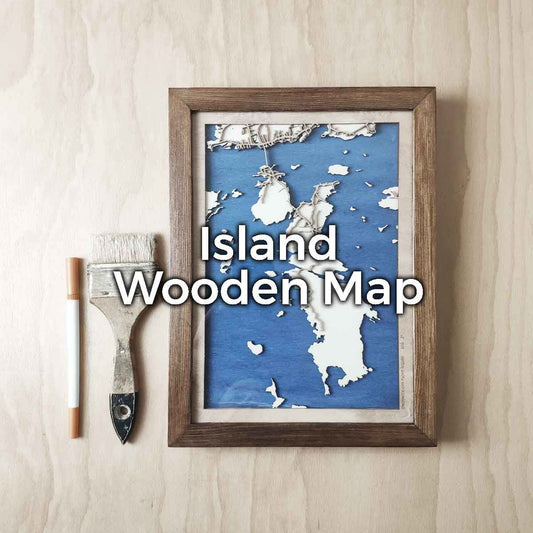Mit dem Laser geschnittene Holzkarten haben in den letzten Jahren an Popularität gewonnen und bieten eine einzigartige Möglichkeit, seine Wertschätzung für Geographie, Kunst und Technologie zum Ausdruck zu bringen.
Diese komplexen und optisch beeindruckenden Stücke fangen die Essenz der Topographie unseres Planeten ein und sind somit eine ideale Ergänzung für Ihr Zuhause, Ihr Büro oder als Geschenk für Ihre Lieben.
Mit dem Laser geschnittene Holzkarten sind Teil des wachsenden Trends zur Verwendung der Laserschneidetechnologie in verschiedenen Branchen, darunter auch Kunst und Design.
Historisch gesehen war die Kartografie ein entscheidender Aspekt der menschlichen Zivilisation. Sie half uns bei der Navigation und dem Verständnis der Welt um uns herum.
„Die Laserschneidetechnologie hat die Art und Weise, wie Künstler und Designer Karten erstellen, revolutioniert und ein neues Maß an Detailgenauigkeit und Komplexität hinzugefügt“, sagt Hubert Roguski, Kartograf und Künstler.

Der Einsatz des Laserschneidens bei der Kartografie hat zu mehr Präzision und Detailgenauigkeit geführt und ermöglicht es Künstlern, schöne und genaue Darstellungen unserer Welt zu erstellen.
„Mit dem Laser geschnittene Holzkarten bieten eine einzigartige Kombination aus Handwerkskunst und Technologie, wodurch ein wirklich einzigartiges Stück entsteht“, erklärt Roguski.
Die steigende Popularität dieser Karten hat zu einer Flut von Kleinunternehmen und Künstlern geführt, die sich auf die Anfertigung individueller Stücke für Kunden spezialisiert haben und dabei ein breites Spektrum an Stilen und Techniken vorführen.
CityWood beispielsweise, gegründet von Hubert Roguski, bietet minimalistische Stadtpläne an, bei denen Schichten aus lasergeschnittenem Holz verwendet werden, um eine auffällige 3D-Darstellung urbaner Landschaften zu erstellen.
Der Einfluss lasergeschnittener Holzkarten auf den Bereich der Kartografie und Kunst ist offensichtlich.
Diese Karten haben nicht nur die Aufmerksamkeit von Geographie-Liebhabern erregt, sondern erfreuen sich auch bei Innenarchitekten und Kunstsammlern großer Beliebtheit.
Mit dem Fortschreiten und der Weiterentwicklung der Technologie ist zu erwarten, dass das Design lasergeschnittener Holzkarten immer komplexer und vielfältiger wird.
Dieses Potenzial könnte eine neue Welle von Künstlern, Designern und Kartenliebhabern dazu inspirieren, aus einer künstlerischen Perspektive in die Welt der Kartografie einzutauchen.
Die Beliebtheit lasergeschnittener Holzkarten ist auch ein Zeichen für einen breiteren gesellschaftlichen Wandel hin zu einer größeren Wertschätzung und Würdigung des Handwerks und der Verbindung von Technik und Kunst.
Folglich sind diese Karten zu einem wesentlichen Element in den Bereichen der modernen Kartografie, des Designs und der Ästhetik geworden.

Die Geschichte der Kartografie und der Laserschneidtechnologie
Um die Bedeutung lasergeschnittener Holzkarten voll und ganz zu verstehen, ist es wichtig, den historischen Kontext der Kartografie und die Entwicklung der Laserschneidetechnologie zu verstehen.
Die Kartografie geht auf antike Zivilisationen zurück, wo Karten auf Tontafeln oder Papyrus gezeichnet oder in Stein gemeißelt wurden.
Im Laufe der Geschichte haben Kartografen verschiedene Werkzeuge und Techniken genutzt, um immer genauere und detailliertere Karten zu erstellen.
Die Laserschneidtechnologie hingegen wurde in den 1960er Jahren entwickelt und hat seitdem zahlreiche Branchen verändert, darunter die Fertigungsindustrie, Mode und Kunst.
Aufgrund seiner Präzision und Vielseitigkeit ist das Laserschneiden ein ideales Werkzeug für die Erstellung komplexer Designs, wie beispielsweise der detaillierten Topografie lasergeschnittener Holzkarten.
Der Prozess der Erstellung lasergeschnittener Holzkarten
Die Erstellung lasergeschnittener Holzkarten umfasst mehrere Schritte und beginnt mit der Auswahl eines geografischen Gebiets oder einer Region.
Anschließend beschafft der Künstler genaue topografische Daten aus Quellen wie Satellitenbildern, geologischen Untersuchungen oder Open-Source-Geoinformationssystemen (GIS).
Die Daten werden dann mithilfe einer speziellen Software verarbeitet, die die Informationen in ein mit Laserschneidmaschinen kompatibles Format übersetzt.
Die einzelnen Ebenen der Karte sind so gestaltet, dass sie unterschiedliche Höhen oder Merkmale darstellen, sodass beim Zusammensetzen ein dreidimensionaler Effekt entsteht.
Nachdem der Entwurf fertig ist, wählt der Künstler das geeignete Holzmaterial aus und berücksichtigt dabei Faktoren wie Dicke, Farbe und Maserung.
Anschließend ätzt und schneidet die Laserschneidemaschine das Holz mit bemerkenswerter Präzision, was zu klaren Linien und komplizierten Details führt.
Zum Schluss fügt der Künstler die Schichten zusammen und verleiht der Karte mit einer Schutzschicht das gewisse Etwas, um die Langlebigkeit und optische Attraktivität des Werks sicherzustellen.
Manche Künstler fügen möglicherweise auch Farbe, Beleuchtung oder zusätzliche Verzierungen hinzu, um den ästhetischen Wert der Karte zu steigern.

Der Einfluss lasergeschnittener Holzkarten auf Kunst und Design
Die Verschmelzung von Laserschneidtechnologie und Kartografie hat die Welt der Kunst und des Designs tiefgreifend beeinflusst.
Die Präzision und Vielseitigkeit lasergeschnittener Holzkarten haben die Möglichkeiten der Künstler erweitert und neue Wege für Kreativität und Ausdruck eröffnet.
„Mit dem Laser geschnittene Holzkarten haben die Grenzen der traditionellen Kartografie erweitert und künstlerische Elemente integriert, die diese Stücke nicht nur informativ, sondern auch optisch ansprechend machen“, sagt Hubert Roguski.
Infolgedessen haben lasergeschnittene Holzkarten zahlreiche Künstler und Designer dazu inspiriert, die Schnittstelle zwischen Technologie, Kartografie und Kunst zu erkunden, was zu einer Flut innovativer und einzigartiger Kreationen geführt hat.
Umweltaspekte und nachhaltige Praktiken
In der heutigen Welt sind Nachhaltigkeit und Umweltbewusstsein wichtige Überlegungen für Verbraucher und Hersteller.
Viele Künstler und auf lasergeschnittene Holzkarten spezialisierte Unternehmen haben dies erkannt und umweltfreundliche Verfahren eingeführt, um ihre Auswirkungen auf die Umwelt zu minimieren.
Zu diesen Vorgehensweisen können die Verwendung nachhaltig gewonnener Holzmaterialien, die Wiederverwendung von Verschnitt und der Einsatz energieeffizienter Laserschneidmaschinen gehören.
Durch den Einsatz nachhaltiger Methoden kann die Branche der lasergeschnittenen Holzkarten weiterhin florieren und gleichzeitig ihren ökologischen Fußabdruck reduzieren.
Lasergeschnittene Holzkarten als pädagogisches Hilfsmittel
Abgesehen von ihrer ästhetischen Anziehungskraft können lasergeschnittene Holzkarten auch als wertvolles pädagogisches Hilfsmittel dienen und Menschen aller Altersgruppen dabei helfen, ein tieferes Verständnis für Geografie, Topografie und räumliche Zusammenhänge zu entwickeln.
Beispielsweise können Schulen und Bildungseinrichtungen lasergeschnittene Holzkarten verwenden, um Schülern interaktive Lernerfahrungen zu vermitteln und ihnen so eine größere Wertschätzung für die Welt um sie herum zu vermitteln.
Darüber hinaus können diese Karten eine wertvolle Ressource für Forscher, Stadtplaner und Umweltwissenschaftler sein, da sie detaillierte, genaue und visuell ansprechende Darstellungen bestimmter geografischer Gebiete bieten.

Die Zukunft lasergeschnittener Holzkarten
Mit fortschreitender Technologie werden sich lasergeschnittene Holzkarten wahrscheinlich weiterentwickeln und ihr Design wird noch komplexer und vielfältiger werden.
Dies kann die Einbeziehung neuer Materialien, innovativer Techniken und sogar Interaktivität beinhalten, sodass Benutzer auf neue Weise mit den Karten interagieren können.
Da die Laserschneidetechnologie immer zugänglicher und kostengünstiger wird, ist zu erwarten, dass sich mehr Künstler und Designer für dieses Feld interessieren werden. Dieser Zustrom an Talenten wird wahrscheinlich zu einer vielfältigeren Palette an Stilen, Methoden und einfallsreicheren Anwendungen der Kartografie im Bereich lasergeschnittener Holzkarten führen.




